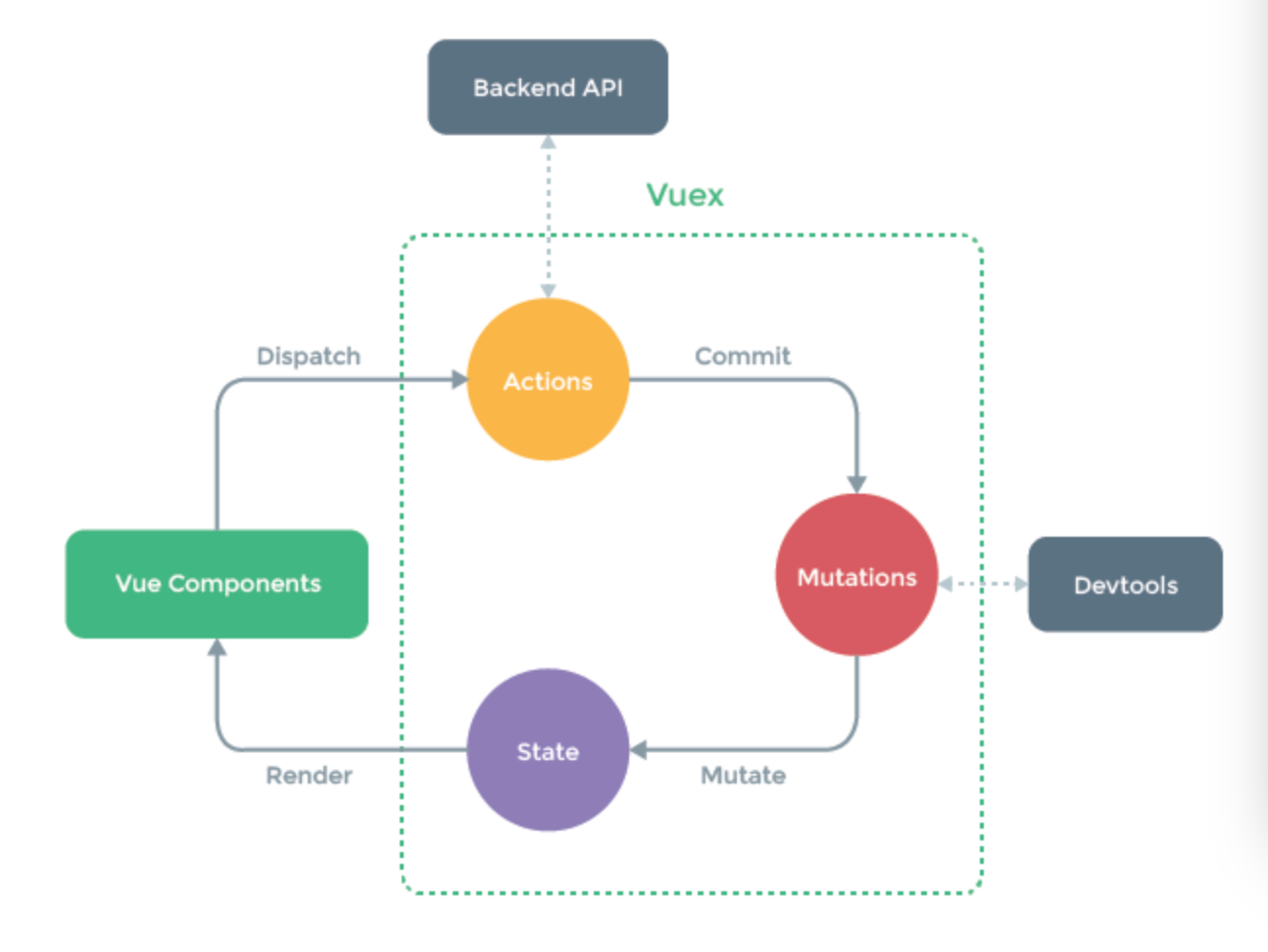vuex详解
yarn add vuex
1、vuex流程图
vuex可以帮助我们管理组件间公共的数据

创建一个 store
// 如果在模块化构建系统中,请确保在开头调用了 Vue.use(Vuex) const store = new Vuex.Store({ state: { count: 0 }, mutations: { increment (state) { state.count++ } } })
现在,你可以通过 store.state 来获取状态对象,以及通过 store.commit 方法触发状态变更:
store.commit('increment')
console.log(store.state.count) // -> 1
2、详解(state)
由于 Vuex 的状态存储是响应式的,从 store 实例中读取状态最简单的方法就是在计算属性中返回某个状态:
// 创建一个 Counter 组件 const Counter = { template: `<div>{{ count }}</div>`, computed: { count () { return store.state.count } } }
每当 store.state.count 变化的时候, 都会重新求取计算属性,并且触发更新相关联的 DOM。
这种模式导致组件依赖全局状态单例
所以,
Vuex 通过 store 选项,提供了一种机制将状态从根组件“注入”到每一个子组件中(需调用 Vue.use(Vuex)):
const app = new Vue({ el: '#app', // 把 store 对象提供给 “store” 选项,这可以把 store 的实例注入所有的子组件 store, components: { Counter }, template: ` <div class="app"> <counter></counter> </div> ` })
通过在根实例中注册 store 选项,该 store 实例会注入到根组件下的所有子组件中,且子组件能通过 this.$store 访问到。让我们更新下 Counter 的实现:
const Counter = { template: `<div>{{ count }}</div>`, computed: { count () { return this.$store.state.count } } }
mapState辅助函数
当一个组件需要获取多个状态时候,将这些状态都声明为计算属性会有些重复和冗余。
为了解决这个问题,我们可以使用 mapState 辅助函数帮助我们生成计算属性,让你少按几次键:
// 在单独构建的版本中辅助函数为 Vuex.mapState import { mapState } from 'vuex' export default { // ... computed: mapState({ // 箭头函数可使代码更简练 count: state => state.count, // 传字符串参数 'count' 等同于 `state => state.count` countAlias: 'count', // 为了能够使用 `this` 获取局部状态,必须使用常规函数 countPlusLocalState (state) { return state.count + this.localCount } }) }
3、详解(Getter)
个人理解:相当于获取计算后的state,将state中某个状态进行过滤,然后获取新的状态
Vuex 允许我们在 store 中定义“getter”(可以认为是 store 的计算属性)。
就像计算属性一样,getter 的返回值会根据它的依赖被缓存起来,
且只有当它的依赖值发生了改变才会被重新计算。
Getter 接受 state 作为其第一个参数:
const store = new Vuex.Store({ state: { todos: [ { id: 1, text: '...', done: true }, { id: 2, text: '...', done: false } ] }, getters: { doneTodos: state => { return state.todos.filter(todo => todo.done) } } })
Getter 会暴露为 store.getters 对象,你可以以属性的形式访问这些值:
store.getters.doneTodos // -> [{ id: 1, text: '...', done: true }]
Getter 也可以接受其他 getter 作为第二个参数:
getters: { // ... doneTodosCount: (state, getters) => { return getters.doneTodos.length } }
可以通过让 getter 返回一个函数,来实现给 getter 传参。在你对 store 里的数组进行查询时非常有用。
getters: { // ... getTodoById: (state) => (id) => { return state.todos.find(todo => todo.id === id) } } store.getters.getTodoById(2) // -> { id: 2, text: '...', done: false }
getter 在通过方法访问时,每次都会去进行调用,而不会缓存结果
mapGetters辅助函数
仅仅是将 store 中的 getter 映射到局部计算属性:
import { mapGetters } from 'vuex'
export default {
// ...
computed: {
// 使用对象展开运算符将 getter 混入 computed 对象中
...mapGetters([
'doneTodosCount',
'anotherGetter',
// ...
])
}
}
4、详解(Mutation)
更改 Vuex 的 store 中的状态的唯一方法是提交 mutation
Vuex 中的 mutation 非常类似于事件:
每个 mutation 都有一个字符串的 事件类型 (type) 和 一个 回调函数 (handler)。
这个回调函数就是我们实际进行状态更改的地方,
并且它会接受 state 作为第一个参数:
const store = new Vuex.Store({ state: { count: 1 }, mutations: { increment (state) { // 变更状态 state.count++ } } })
store.commit('increment')
可以向 store.commit 传入额外的参数,即 mutation 的 载荷(payload):
// ... mutations: { increment (state, n) { state.count += n } } store.commit('increment', 10)
mutation 必须是同步函数
你可以在组件中使用 this.$store.commit('xxx') 提交 mutation,
或者使用 mapMutations 辅助函数将组件中的 methods 映射为
store.commit 调用(需要在根节点注入 store)。
import { mapMutations } from 'vuex'
export default {
// ...
methods: {
...mapMutations([
'increment', // 将 `this.increment()` 映射为 `this.$store.commit('increment')`
// `mapMutations` 也支持载荷:
'incrementBy' // 将 `this.incrementBy(amount)` 映射为 `this.$store.commit('incrementBy', amount)`
]),
...mapMutations({
add: 'increment' // 将 `this.add()` 映射为 `this.$store.commit('increment')`
})
}
}
5、详解(Action)
Action 类似于 mutation,不同在于:
- Action 提交的是 mutation,而不是直接变更状态。
- Action 可以包含任意异步操作。
我们可以在 action 内部执行异步操作:
actions: { incrementAsync ({ commit }) { setTimeout(() => { commit('increment') }, 1000) } }
Actions 支持同样的载荷方式和对象方式进行分发:
// 以载荷形式分发 store.dispatch('incrementAsync', { amount: 10 }) // 以对象形式分发 store.dispatch({ type: 'incrementAsync', amount: 10 })
在组件中使用 this.$store.dispatch('xxx') 分发 action,
或者使用 mapActions 辅助函数将组件的 methods 映射为
store.dispatch 调用(需要先在根节点注入 store):
import { mapActions } from 'vuex'
export default {
// ...
methods: {
...mapActions([
'increment', // 将 `this.increment()` 映射为 `this.$store.dispatch('increment')`
// `mapActions` 也支持载荷:
'incrementBy' // 将 `this.incrementBy(amount)` 映射为 `this.$store.dispatch('incrementBy', amount)`
]),
...mapActions({
add: 'increment' // 将 `this.add()` 映射为 `this.$store.dispatch('increment')`
})
}
}
store.dispatch 可以处理被触发的 action 的处理函数返回的 Promise,
并且 store.dispatch 仍旧返回 Promise:
actions: { actionA ({ commit }) { return new Promise((resolve, reject) => { setTimeout(() => { commit('someMutation') resolve() }, 1000) }) } }
一个action中
store.dispatch('actionA').then(() => {
// ...
})
另一个action中
actions: { // ... actionB ({ dispatch, commit }) { return dispatch('actionA').then(() => { commit('someOtherMutation') }) } }
我们利用 async / await
// 假设 getData() 和 getOtherData() 返回的是 Promise actions: { async actionA ({ commit }) { commit('gotData', await getData()) }, async actionB ({ dispatch, commit }) { await dispatch('actionA') // 等待 actionA 完成 commit('gotOtherData', await getOtherData()) } }
一个 store.dispatch 在不同模块中可以触发多个 action 函数。
在这种情况下,只有当所有触发函数完成后,返回的 Promise 才会执行。
以后再更。